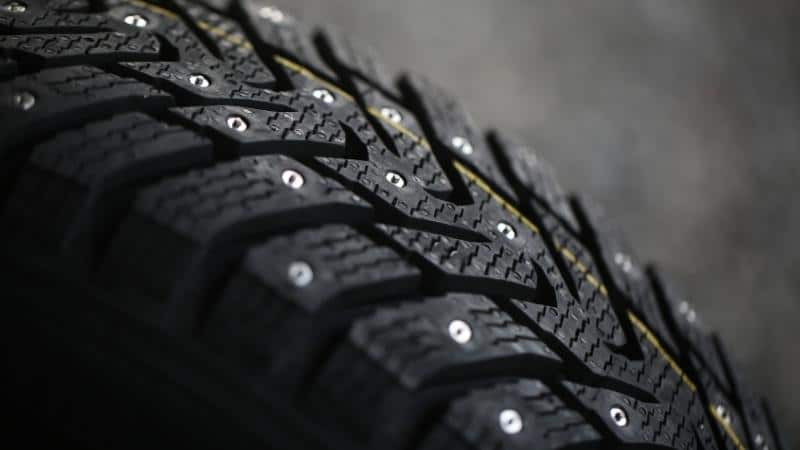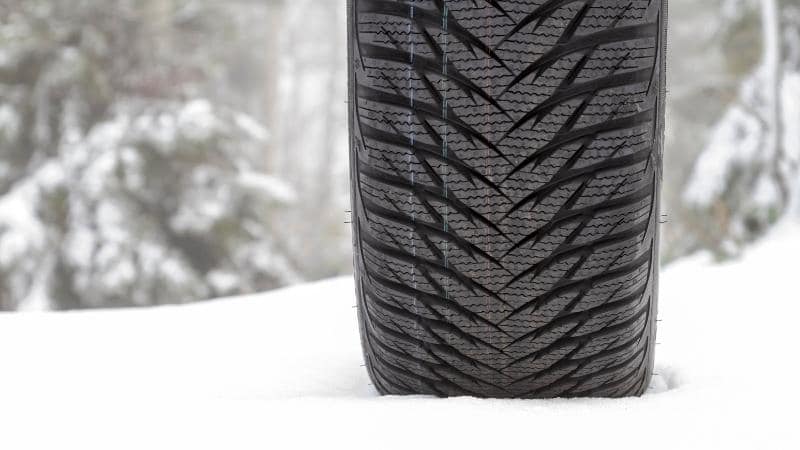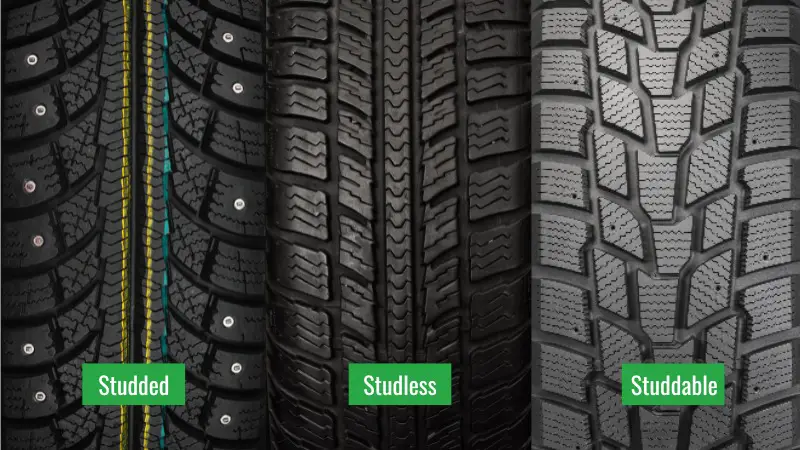When winter arrives, it’s crucial to ensure that your vehicle has the right tires to handle the snow and ice. The three main options for winter tires are studded, studless, and studdable.
In order to choose the right ones for your needs, it’s essential to understand the differences between them and how they perform in various conditions.
Studded tires are designed with small metal spikes embedded in the tread, which provide exceptional traction on ice and packed snow. While they are highly effective in extreme winter conditions, their drawback is the increased road noise and potential damage they can cause to road surfaces.
On the other hand, studless tires rely on specially designed tread patterns and rubber compounds to maintain flexibility and grip in cold temperatures, making them a popular choice for drivers who face a mix of winter conditions.
Studdable tires offer a hybrid option between studded and studless tires. They feature predrilled holes in the tread, allowing you to add or remove studs depending on the conditions you’re driving in.
This versatility makes them an attractive choice for many drivers looking for the best balance between performance and adaptability in winter driving situations.
Understanding Winter Tire Types
In this section, you will learn about the different types of winter tires: studded, studless, and studdable. Each type has its advantages and can be more suitable for specific driving conditions.
Knowing the differences will help you make the right choice for your vehicle and the winter conditions in your area.
Studded Tires

Studded tires have metal studs embedded in their treads, which provide excellent traction on ice and packed snow. These studs cut into the frozen surfaces and give you better grip when driving in slippery conditions.
However, they can also cause increased road noise and reduce fuel efficiency. Additionally, studded tires are prohibited in some areas due to concerns about road damage, so check your local regulations before considering this option.
Studless Tires

Studless tires do not have metal studs, but they are made of a softer and more flexible rubber compound, which helps them maintain grip on snow and slush. The tread contains wide, deep grooves and sharp edges to cut through snow and grip the road effectively.
Although they don’t offer the same level of traction on ice as studded tires, studless tires perform well on slush and packed snow and can be a good option for areas with frequent snowfall and slushy roads.
Studdable Tires
Studdable tires are a hybrid between studded and studless tires. They have predrilled holes in the tread, where you can insert and remove metal studs. When studs are added, these tires provide great traction on snow and heavy ice, almost similar to studded tires.
However, you can remove the studs when you drive on less treacherous roads, making them a more versatile option. It’s important to note that adding and removing studs might require professional assistance.
As you learn about each type of winter tire, keep in mind the specific winter driving conditions in your region and the kind of performance you expect from your vehicle.
Understanding the differences between studded, studless, and studdable tires will help you make an informed decision that ensures your safety and comfort during winter months.
Factors to Consider When Choosing Type of Winter Tires
Climate and Weather Conditions
The winter conditions in your area have a significant impact on the type of tire that suits your needs.
If you frequently drive in heavy snow and ice, you may want to choose studded snow tires for their superior traction. If you encounter more wet or slushy conditions, studless tires could offer better performance.
Driving Habits and Road Types
Consider your driving style and the types of roads you typically travel on. For city or highway driving with occasional snowy conditions, studless tires may provide a smoother, quieter ride.
If your winter driving includes more challenging roads with packed snow and ice, studded or studdable tires can give you an added level of traction and safety.
Performance Requirements
Your vehicle’s handling and performance requirements also play a role in tire selection. For instance, performance-oriented vehicles may benefit from specialized winter tires designed for high speeds and cornering ability.
On the other hand, a more conventional set of winter tires might suffice for the average commuter vehicle.
Compare the recommended tire measurements in your owner’s manual or on the driver’s side door jamb to ensure you select the appropriate winter tire size for your vehicle.
Legal Restrictions
Don’t forget to check your local laws and regulations. Some areas have restrictions on the use of studded tires during specific months or in certain conditions.
Studded Tire Laws in the US: Permitted Dates by Region and State
Studded tire laws in the United States vary by state, with some states allowing their use during specific winter months, others restricting their use entirely, and some permitting them all year.
Below is a general overview of studded tire regulations in different regions of the U.S. Note that these laws are subject to change and it is always advisable to check with your local Department of Transportation for the most up-to-date regulations.
Northeast:
| State | Permitted Dates |
|---|---|
| Maine | Oct 2 – Apr 30 |
| New Hampshire | Nov 1 – Apr 30 |
| Vermont | Nov 1 – Apr 14 |
| Massachusetts | Nov 2 – Apr 30 |
| Rhode Island | Prohibited |
| Connecticut | Nov 15 – Apr 30 |
Mid-Atlantic:
| State | Permitted Dates |
|---|---|
| New York | Oct 16 – Apr 30 |
| New Jersey | Nov 15 – Apr 1 |
| Pennsylvania | Nov 1 – Apr 15 |
| Delaware | Prohibited |
| Maryland | Nov 1 – Mar 31 |
| Washington D.C. | Prohibited |
Southeast:
| State | Permitted Dates |
|---|---|
| Virginia | Oct 15 – Apr 15 |
| West Virginia | Nov 1 – Apr 15 |
| North Carolina | Prohibited |
| South Carolina | Prohibited |
| Georgia | Prohibited |
| Florida | Prohibited |
Midwest:
| State | Permitted Dates |
|---|---|
| Ohio | Nov 1 – Apr 15 |
| Indiana | Oct 1 – May 1 |
| Michigan | Nov 1 – Apr 15 |
| Illinois | Prohibited |
| Wisconsin | Nov 15 – Apr 1 |
| Minnesota | Non-residents: 30 days |
| Iowa | Nov 1 – Apr 1 |
| Missouri | Nov 2 – Mar 31 |
Great Plains:
| North Dakota | Oct 15 – Apr 15 |
| South Dakota | Oct 1 – Apr 30 |
| Nebraska | Nov 1 – Apr 1 |
| Kansas | Nov 1 – Apr 1 |
| Oklahoma | Nov 1 – Apr 1 |
| Texas | Prohibited |
Mountain West:
| State | Permitted Dates |
|---|---|
| Montana | Oct 1 – May 31 |
| Idaho | Oct 1 – Apr 30 |
| Wyoming | Nov 1 – Apr 30 |
| Colorado | Nov 1 – May 31 |
| Utah | Oct 15 – Apr 15 |
| Nevada | Oct 1 – Apr 30 |
Southwest:
| State | Permitted Dates |
|---|---|
| Arizona | Oct 1 – May 1 |
| New Mexico | Oct 1 – Apr 1 |
| California | Nov 1 – Apr 30 |
Pacific Northwest:
| State | Permitted Dates |
|---|---|
| Washington | Nov 1 – Mar 31 |
| Oregon | Nov 1 – Mar 31 |
Alaska and Hawaii:
| State | Permitted Dates |
|---|---|
| Alaska (Southcentral) | Sep 16 – Apr 30 |
| Alaska (Northern) | Oct 1 – Apr 14 |
| Hawaii | Prohibited |
Remember that these laws can change, and it is essential to verify the most current regulations with your local Department of Transportation before using studded tires.
Additionally, it is important to consider alternatives like studless winter tires, which provide excellent traction in winter conditions without the potential road damage caused by studded tires.
Comparing the Advantages and Disadvantages
Studded Tires Advantages and Disadvantages
Studded tires have metal studs embedded in the rubber tread for increased grip on icy surfaces. Here are the primary advantages and disadvantages of studded tires:
| Advantages | Disadvantages |
|---|---|
| Excellent ice grip | Limited to winter use only |
| Good traction on hard-packed snow | Increased road noise |
| Confidence in extreme winter conditions | Increase in road wear |
| Restricted or prohibited in some areas |
Studless Tires Advantages and Disadvantages
Studless winter tires do not have metal studs, but they use hydrophilic rubber compounds and advanced tread designs for grip on snowy and icy surfaces. Here are the main advantages and disadvantages of studless tires:
| Advantages | Disadvantages |
|---|---|
| Superior grip on snow and ice compared to all-season tires | Can be less effective on ice compared to studded tires |
| More environmentally friendly | Recommended for winter use only |
| Quieter than studded tires | Reduced dry pavement performance |
| Unrestricted use in all areas |
Studdable Tires Advantages and Disadvantages
Studdable winter tires allow the option for the owner to add metal studs for enhanced grip. It combines the benefits of both studded and studless tires. Here are the main advantages and disadvantages of studdable tires:
| Advantages | Disadvantages |
|---|---|
| Versatility (can be used with or without studs) | Reduced grip when not using studs |
| Option for better ice grip with studs | Potential increased road noise when studded |
| Good traction on snow and ice | Limited to winter use only |
| Studs subject to restrictions in some areas |
Choose the winter tire type that best suits your needs and local regulations. Knowing the advantages and disadvantages will help you make an informed decision.
Making an Informed Decision
To make an informed decision when choosing winter tires, first assess the winter conditions in your area. If you frequently drive on icy roads or packed snow, studded tires may be the best option for you. These tires have small metal spikes that provide excellent traction on icy surfaces.
However, some states have regulations on the use of studded tires, so make sure to check the laws in your area before purchasing. Studded tires may not be ideal for urban driving, and they can cause more road wear.
If you’re looking for an alternative to studded tires, consider studless or “friction” tires. These tires are suitable for urban winter driving and generally perform well in various winter conditions, including snow and slush.
Another option is studdable tires, which provide the flexibility of using them as studless tires or adding studs for extra traction when needed.
As you weigh your options, also consider the following factors for choosing the right winter tires:
- Driving habits and frequency
- Tire performance in various winter conditions
- Cost and durability
Remember to research top-rated winter tire models such as the Bridgestone Blizzak WS90, Michelin X-Ice Snow, and Nokian Hakkapeliitta R5. These tires have been well-reviewed for their performance in winter conditions.
By considering your region’s winter conditions, driving habits, and top-rated tire models, you’ll be able to confidently choose the right winter tires for your vehicle.
Proper Tire Maintenance and Care
When it comes to winter tires, proper maintenance and care is essential to ensure their performance and longevity. Here are some tips to help you maintain your studded, studless or studdable winter tires.
Regularly inspect your tires: Check your tires for any visible signs of damage, such as cuts, punctures, or excessive wear. Look for any missing studs (if applicable) and replace them if necessary. See if there is any uneven wear, which may indicate misalignment or improper inflation. Regularly inspecting your tires can help identify potential issues early and prolong their lifespan.
Rotate your tires: Rotating your tires according to the manufacturer’s recommendation (usually every 5,000 to 8,000 miles) is crucial for even tread wear. This can help extend the life of your tires and maintain their performance. Remember to consult your vehicle’s owner’s manual for the recommended rotation pattern and interval for your specific vehicle.
Check tire pressure: Proper tire inflation is essential for optimal handling, fuel efficiency, and tire life. Check your tire pressure at least once a month and before long trips. Make sure to follow the inflation guidelines specified in your vehicle’s owner’s manual or on the tire information placard. Keep in mind that tire pressure can drop due to lower temperatures in winter, so make sure to adjust accordingly.
Store them properly: If you switch between winter and all-season tires, store the off-season set in a cool, dry, and dark location. Stack them horizontally, or hang them individually if possible, to avoid unnecessary stress and deformation. Proper storage helps preserve their condition and prolong their life.
By following these maintenance and care tips, you can ensure that your winter tires remain in optimal condition and provide you with the necessary traction and safety throughout the colder months.
Hi, my name is Niklas, the head content creator & CEO of Whirling Wheelz. I am very interested in vehicles of all kinds, mainly cars. I have a car mechanics degree from high school and a big hobby of mine is to follow the WRC (World Rally Championship) both online and through travel.


